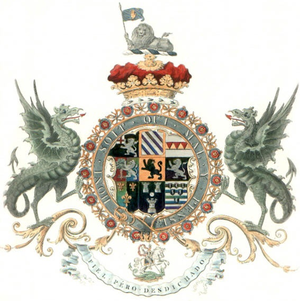Wyvern

A wyvern /ˈwaɪvərn/, sometimes spelled wivern, is a legendary winged creature with a dragon's head, which may be said to breathe fire or possess a venomous bite, a reptilian body, two legs (sometimes none), and a barbed tail. A sea-dwelling variant, termed the sea-wyvern, has a fish tail in place of a barbed dragon's tail. The wyvern in its various forms is important to heraldry, frequently appears as a mascot of schools and athletic teams (chiefly in the United States and United Kingdom), and occasionally appears in medieval and modern European and British literature as well as a multitude of video games.
Etymology
The usual spelling wyvern is not attested before the 17th century as "winged two-footed dragon".[1] It is an alteration of Middle English (attested 13th century) wyver, from Old French wivre (cf. French guivre and vouivre), itself from Latin vīpera, meaning 'viper', 'adder', 'asp'.[1][2]
In literature
The wyvern features frequently in modern fantasy fiction, though its first literary appearances may have been in medieval bestiaries.[3]
In heraldry

The wyvern is a frequent charge in English heraldry and vexillology, also occasionally appearing as a supporter or crest.
A white (argent) wyvern formed the crest of the Borough of Leicester as recorded at the heraldic visitation of Leicestershire in 1619: A wyvern sans legs argent strewed with wounds gules, wings expanded ermine. The term sans legs may not imply that the wyvern was "without legs", rather that its legs are not depicted, being hidden or folded under.[4][5][6] This was adopted by the Midland Railway in 1845, when it became the crest of its unofficial coat of arms.[7] The company asserted that the "wyvern was the standard of the Kingdom of Mercia", and that it was "a quartering in the town arms of Leicester".[8][9][10][11] However, in 1897 the Railway Magazine noted that there appeared "to be no foundation that the wyvern was associated with the Kingdom of Mercia".[9]
The Kings of Aragon of the House of Barcelona since Peter IV used a wyvern as a crest on their helmets.[citation needed] Nowadays this symbol has been officially adopted as the coat of arms of the Generalitat Valenciana (Valencian Parliament and Government). Wyverns are also an important part of the mythological animals in many traditional local festivals of Catalonia.[citation needed]
As a logo or mascot
The wyvern is also a fairly popular commercial logo or mascot, especially in Wales and what was once the West Country Kingdom of Wessex, but also farther afield in Herefordshire and Worcestershire, as the rivers Wye and Severn run through Hereford and Worcester respectively. For example, a local school travel company is called Wyvern Schooltours Ltd and one of the local radio stations is called Wyvern FM.[12][13] Vauxhall Motors had a model in its range in the 1950s called the Wyvern. The Westland Wyvern was a British single-seat carrier-based multi-role strike aircraft built by Westland Aircraft that served in the 1950s, seeing active service in the 1956 Suez Crisis.
The wyvern is a frequent mascot of athletic teams, colleges and universities, particularly in the United Kingdom and the United States, and is the mascot of the Korean Baseball Organization team SK Wyverns, established in 2000.
Examples

|

|
File:Arms-leicester.png | 
|

|
| A wyvern fighting with a wolf, relief, Trento Cathedral, Italy | A carved wyvern on the choir stalls of Chester Cathedral in Cheshire, England, c. 1380 | Coat of arms, City of Leicester, bearing in crest a wyvern argent sans legs | Arms of Midland Railway at Derby station, bearing in crest a wyvern sans legs | Municipal arms of Stjørdal, Norway |
See also
References
- ^ a b Hoad, T. F. (1993). English Etymology. Oxford: Oxford University Press. p. 546. ISBN 0-19-283098-8.
- ^ "Oxford English Dictionary" (Second ed.). November 2010. Retrieved 2011-02-18.[dead link]
- ^ A wyvern and an elephant may be found at Harley MS 3244 (dated 13th century, after c. 1236), f.39v.
- ^ Geoffrey Briggs, Civic & Corporate Heraldry, London 1971
- ^ C. W. Scot-Giles, Civic Heraldry of England and Wales, 2nd edition, London, 1953
- ^ A. C. Fox-Davies, The Book of Public Arms, London 1915
- ^ Cuthbert Hamilton Ellis, The Midland Railway, 1953
- ^ Frederick Smeeton Williams, The Midland Railway: Its rise and progress: A narrative of modern enterprise, 1876
- ^ a b The Railway Magazine, Vol. 102, 1897
- ^ Dow (1973)
- ^ Clement Edwin Stretton, History of The Midland Railway, 1901
- ^ "Welcome to Wyvern Schooltours".
- ^ "Wyvern FM". Media UK. Retrieved 2009-06-04.
External links
select an article title from: Wikisource:1911 Encyclopædia Britannica
